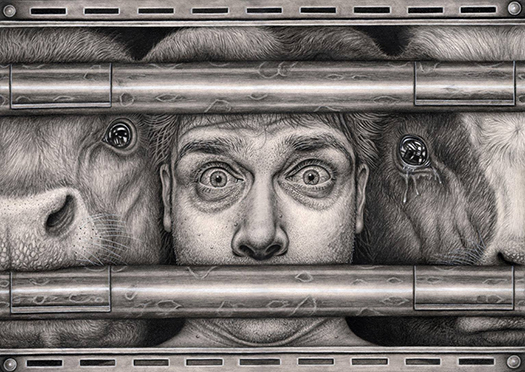My fear

None of us really know how other people or animals experience pain; we only know what we ourselves sense when we are in pain. However, we can safely say that human and non-human animals are sentient creatures, who have the ability to suffer.
The fact that we don’t share a common language with animals does not mean we do not recognize when they are in pain. We know when humans who cannot communicate verbally (such as babies, or people with verbal or cognitive impairments) experience pain; similarly we can see it in non-human animals. Their behavior demonstrates their suffering, for instance, they eat less and tend not to interact. When the source of pain is external, animals, like humans, try to avoid it and they scream, yelp, or make other sounds when they experience it. They may try to alleviate their pain if possible, for example, chickens who, when injured and lame, chose to eat food containing pain-killing drugs over untreated food, and their walking ability was significantly improved.
Humans and animals share the same pain detection mechanisms. Non-human animals, especially vertebrates, have similar neurological systems to humans: brains and nervous systems. We also share the same physiological responses to pain with many animals, such as increased heart rate and blood pressure, and dilated pupils.
One of the things I fear the most is pain. I’m not talking about a headache, for instance, when the source is my own body, but when the cause is external, induced by someone else, such as a medical procedure. It’s not just the sensation of pain that I dread, it’s also the helplessness, not knowing how painful it’s going to be and how long it’s going to last. This vulnerability of mine informed my thinking and feelings about the pain animals go through for our benefit. This notion that I have caused pain so I can enjoy materials such as cosmetics, wool, milk, and meat, horrified me once I realized how each and every product was produced.
The animals we use for many of our materials are in pain throughout their lives, day in and day out. They are helpless, unable to escape or alleviate the pain, not knowing when it will stop, or resume. In cages, gestation crates, laboratories, slaughter houses, they are terrified. Unlike you when you suffer, they do not have their family or friends by their side to comfort them in their misery, to promise they’ll get better, and that the suffering will end. For them it only gets worse.
Animals’ pain and misery saturate almost everything you touch and consume in your daily life. Household detergents, cosmetics, clothes, and food, to name a few. Detergents which you may clean your home with were poured into rabbits’ eyes and burned their skin, warm sweaters and scarves are made of wool sheared inhumanly or angora which was ripped from rabbits’ skin. Worst of it all (if only for their sheer number) farmed animals such as chickens who were raised in misery and brutally killed (there is no humane killing), only to be served as food.
Please try to envision the animals’ immense pain, it is no different from how you experience it. If we were in their place we’d be terrified, our eyes wide open, our hearts racing, our mouths open, screaming.
I empathize with their suffering when I imagine myself in a full-body restrainer and a chemical is dripping into my eyes, or tied in a filthy cage, my hair is being shaved from my bleeding head, and it’s me in a slaughter house watching with horror my brothers and sisters who are already bleeding, and I’m next…
There is no one there to stop this hell, alleviate my excruciating pain and fear, hold my hand, help me. There are only humans there, preparing me as a product for you.
The absurdity of it all is that we do not need to brutalize animals in order to survive, or live a normal and healthy life. The possibilities are endless when it comes to a lifestyle that excludes violence. You can use many great detergents, grooming products and cosmetics that were not tested on rabbits and other animals, and wear warm garments made of cotton, cotton flannel, polyester fleece, faux shearling, and other cruelty-free fibers, or even reclaimed wool. Most importantly, you can eat a healthy plant based diet that does not include dead animals.
All those options are not only ethical but well within reach, so why not stop contributing to their pain and misery in your daily life?
Picture courtesy of Raj Singh Tattal

I have watched my dogs suffer the loss of their friends, and most recently, I saw how upset my little dog has been because of my surgery. She has not left my side since I returned from the hospital. I am taking her with me as a service dog when I go to California because i believe leaving her home would be cruel.
A simple observation which either escapes most, or which most prefer to ignore. If other animals share the same pain receptors and general neural circuitry for processing pain signals and show behavioural responses to painful stimuli, then why not conclude that they are feeling pain?
What can it be about human behavioural responses that allows us to elevate our experience at the expense of other animals? I suspect it is no more than the fact that most people probably imagine us to be something quite different, quite apart from the rest of nature.
Perhaps most imagine we have a soul, and nothing else does…